| 1 | Yellow-bellied liophis |

The Erythromlamprus snake genus has 55 members, making it one of the largest worldwide, and the most abundant member of all is probably the yellow-bellied liophis (Erythrolamprus poecilogyrus). This is a 60cm, mildly venomous species which inhabits southern Brazil, Paraguay, and Argentina. The yellow-bellied liophis succeeds by being extremely flexible. They have a liking for water bodies, but inhabit primary forests, fields and disturbed forests alike, while they’re active during both day and night.
This species derives 98% of its meals from frogs and toads, and while non-aggressive, their venom is capable of swelling a hand within 15 minutes, after just a few seconds of biting, followed by 3 days of intense muscular pain in the arm, according to a 2010 case report.
This species has an endless roster of sneakier defensive tricks too. They can raise a tail to distract from their brain, hide their head beneath coils, and even spread a small hood like a cobra. Few species match the sheer number of defensive tricks the yellow-bellied liophis has available. There’s biting, triangulating their head to copy a viper, producing a vile smell, gaping their mouth widely to produce an insane appearance. This study found that 15 defensive behaviors had been documented in Erythrolamprus poecilogyrus. They can deploy these methods one after the other, in quick succession, like they’re firing all their defensive cannons at once.
| 2 | Royal marsh snake |
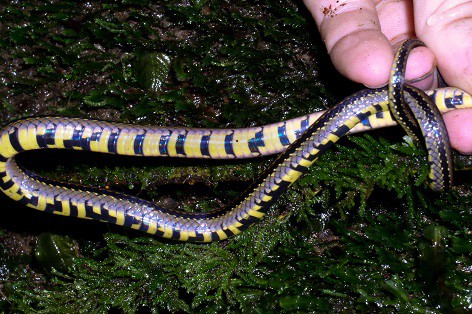
One of the most widespread snake species in Brazil. This species not only inhabits the Amazon rainforest, but the dry east and Atlantic forests of the southeast. There’s no area of Brazil which the royal marsh snake (Erythrolamprus reginae) doesn’t inhabit, and they’re also found in Peru, Bolivia, Guyana, and Ecuador east of the Andes.
Royal marsh snakes are normally found near small ponds, puddles formed by rainwater, and small streams. The reason: this is the main hub for their frog prey. 95% of their diet is amphibians, similarly to the golden bellied liophis. Confirmed prey species include whistling grass frogs, Miranda’s white-lipped frogs, basin white-lipped frogs and Steindachner’s dwarf frog.
Royal marsh snakes are olive grey or green from above. Their belly is the most memorable, with bright yellow or orange overlaid with black squares (see above). Virtually nothing is known about its venom, but Erythrolamprus reginae tends to hold amphibian prey in its mouth for several minutes, as though allowing a potent venom to spread.
Royal marsh snakes mainly hunt by day, but are flexible enough to hunt at night too. This is the most widespread Erythrolamprus member of the 55 in terms of sheer area covered.
| 3 | Mimic coral snake |
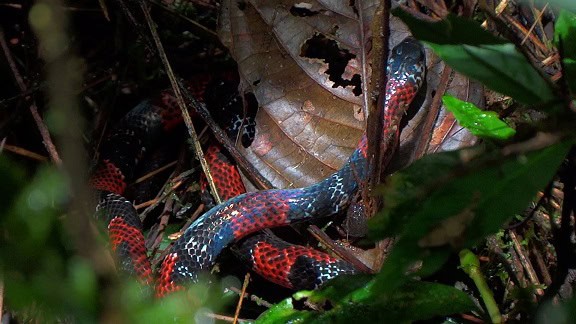
This Erythrolamprus member has no overlap with our previous two, as it lives exclusively west of the Andes. That means western Ecuador and western Colombia, plus Panama, Costa Rica and Nicaragua in Central America.
This mildly venomous snake averages at 40cm with a record of 74.5cm. South America is full of coral snake mimics, but this is one of the most blatant. Erythrolamprus mimus closely mimics the black-white-red bands of its neurotoxic neighbors, with white forming the smallest spaces. In Ecuador, it mimics the trans-Andean coral snake, while in Colombia, it resembles the pygmy coral snake.
Up close though, they’re easy to distinguish because of their far larger eyes. Another ID sign is that the rings are broken on the belly, whereas in coral snakes the rings are fully encircling.
Mammals are completely off the menu for this species. Fellow snakes form the bulk, including sleepy ground snakes and Ecuadorian centipede snakes, with lizards as a backup. While no chemical analysis has been performed of their venom, victims have experienced pain and swelling. Bites are rare, as mimic coral snakes prefer to flatten their body to create an illusion of size, or flee rapidly into bushes.
This species is often spotted in coffee plantations, particularly in Ecuador’s Intag valley, and stick to the ground rather than climbing trees. Within the family, mimic coral snakes are most closely related to Erythrolamprus bizona.
| 4 | Almaden ground snake |
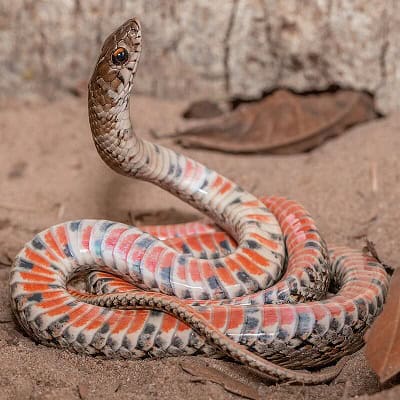
This species covers a huge swathe of southern Brazil, but is less commonly sighted than the yellow-bellied liophis. Almadan ground snakes (Erythrolamprus almadensis) also cross into Paraguay, Uruguay and northern Argentina, and are easily recognized by a reddish underbelly. They mainly inhabit grassy, hilly areas with plenty of moisture, where they fall victim to many predators.
In October 2015, scientists spotted a web in a dark rock hollow. Caught in it was an Alamadan ground snake, partly decomposed, accompanied by a Uruguay black beauty tarantula feasting on the flesh around its belly. Amphibians also join the feast, as a northeastern pepper toad was spotted eating an Almadan ground snake near the Brazilian city of Capela.
Overall, this is one of the more mysterious, poorly researched family members, including their venom. Almadan ground snakes rarely bite, and prefer to flee, or use the classic Erythrolamprus trick of flattening their body. This species is most closely related to Jaeger’s ground snake, also found in Uruguay and Paraguay.
| 5 | Common coral grass snake |
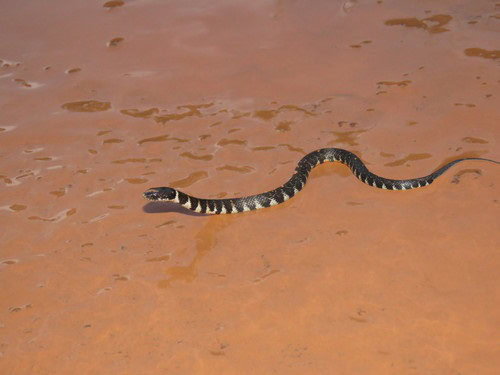
This species skips the densely inhabited southern areas of Brazil like Sao Paulo, but has a huge east-west span, appearing on the Atlantic coast, and crossing into Peru to the far west. Within that large territory, this is an elusive snake which successfully slips under the radar.
This is a richly coloured snake, with a dark green-black body, like the forest slime of 1000 years, followed by a red belly, with a domino white underside of the tail. Erythrolamprus taeniogaster has a unique diet for its family, preying mainly on fish rather than frogs. In a 2022 study, scientists gathered 226 individuals, and found 64 identifiable prey items within. This was neatly broken down into 73% (47) fish, and 27% frogs and toads (17). One favorite included Synbranchus swamp eels, a favorite of the 2.5 metre Brazilian smooth snake, meaning that Erythrolamprus taeniogaster has a brutal competitor roaming the jungle.
Because of its diet, Erythrolamprus taeniogaster is nearly always found near water bodies. They prefer slow-flowing waters rich with floating vegetation, often murky waters with a low depth. E. taeniogaster swallows its prey by the head, and tends to hunt diurnally (day-faring). It’s theorized that they seek out resting frogs and fish by invading their sanctuary hollows.
| 6 | Julia’s ground snake |
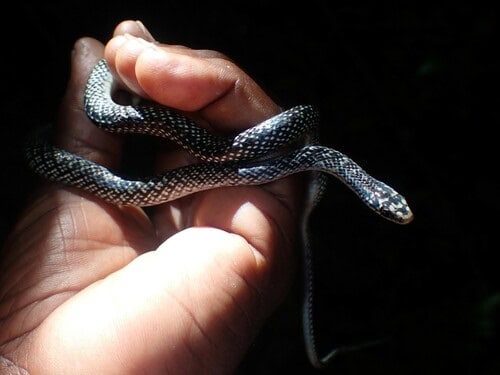
Our first island-based Erythrolamprus member. Julia’s ground snake (Erythrolamprus juliae) lives mainly on the Caribbean island of Dominica, where it’s one of just 4 native snakes, the others being the boa constrictor, Dominican blind snake and Dominican racer. From a distance, they look like they’re dull grey, but up close, they’re actually patterned with rapidly alternating snowy white and pitch black.
Julia’s ground snake inhabits the whole of Dominica except the high mountains, such as Morne Diablotin (1447 metres), the island’s highest peak. They appear in rainforest margins and deciduous woodland, but drier coastal woodlands are their favorite habitat. While this snake is poorly researched, its diet is said to contain lizards, amphibians and insects. Julia’s ground snake is also found on Guadeloupe to the north, a French overseas territory, but is much rarer, possibly due to the invasive mongoose (which tend to decrease snakes wherever they arrive).
Their closest relative is another island member, Lacépède’s ground snake (Erythrolamprus cursor), found exclusively on Martinique. These two islands are less than 15 MYA\old, leading scientists to believe that the two Erythrolamprus members colonized them by overwater travel.
| 7 | Velvety swamp snake |
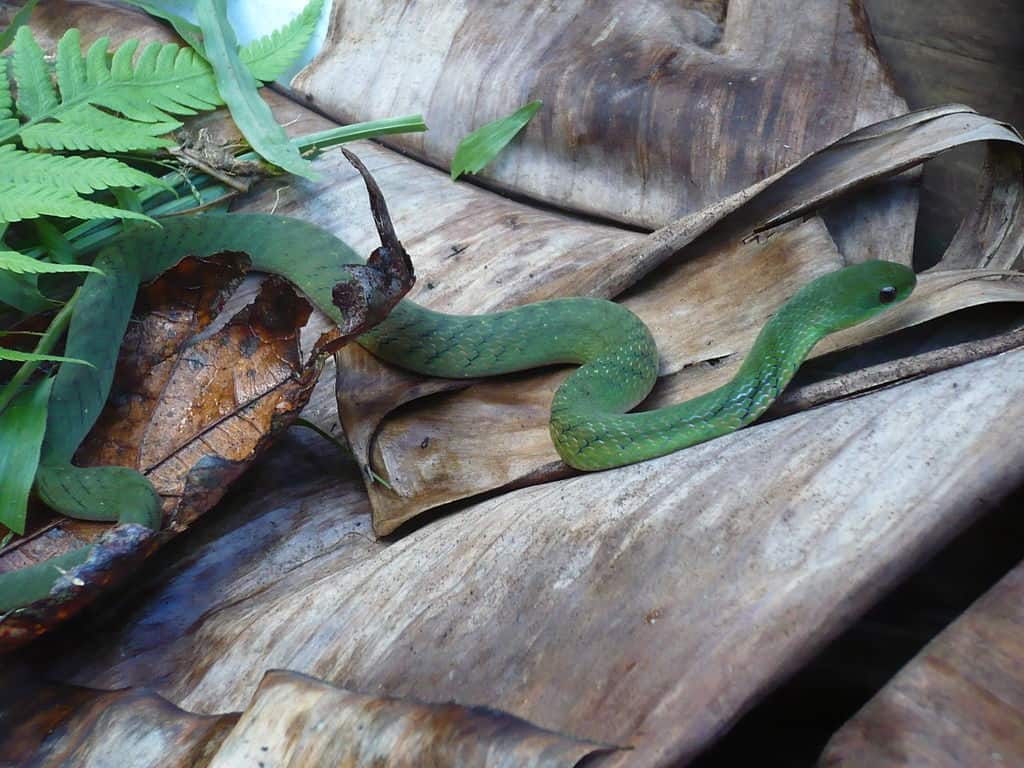
Perhaps the most loveable member of the Erythrolamprus family. This 60cm species looks more at home in Toys R Us than a humid rainforest filled with cackling monkeys. Velvety swamp snakes inhabit the vast majority of Brazil, particularly the Amazon rainforest, but also the outskirts of Sao Paulo, Brazil’s largest city, where there’s a high density of sightings.
This snake has an enormous number of morphs. Plain green is typical, but sometimes overlaid with black spots. Then there’s blue, orange, or purple, and the colours always have a strange silky or velvety quality to them, hence the name.
This image shows a velvety swamp snake widening its neck, revealing electric blue skin between its scales. This freaky image shows one of the bluest snakes ever seen. Not only are its body and tongue fully blue, but it has one of the widest horizontally enlarged necks outside the cobra family. This individual looks like a stuffed animal from the Seaworld gift shop.
In 2022, scientists picked up a velvety swamp snake, only for it to begin releasing strange white drops of liquid. When they later returned, the white droplets also returned. This has never been observed in the Erythrolamprus family before, and the purpose was unknown. It may be similar to red-necked keelbacks in Thailand, which swallow toads and store their toxins as a milky white liquid, releasing them at enemies. Adding more clues, velvety swamp snakes are confirmed to prey on Rhinella proboscidea, a highly toxic toad species.
If you find the velvety swamp snake, take your photo quickly. It’s more than possible to rummage in your backpack, look up, and find that they’ve fled into the undergrowth in just two seconds.
| 8 | Erythrolamprus mossoroensis |
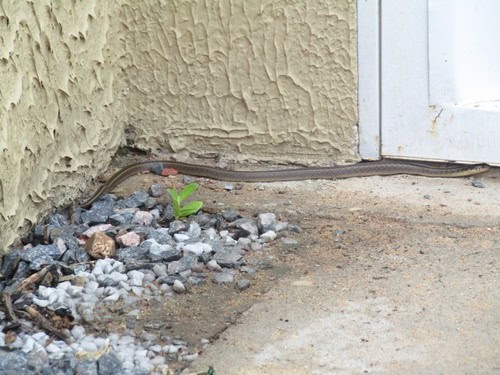
This member lives mainly in eastern Brazil, including Paraíba state, the easternmost state of all, and the easternmost point of South America. Erythrolamprus mossoroensis is active during both day and night, and is a relatively sparse snake within its territories. In eastern Brazil, E. mossoroensis is commonly known as Cobra-d’Água, or water snake, and it associates closely with small water bodies. This is one of the dullest Erythrolamprus members, with no neon red or orange even on its belly.
Nothing is known about the venom of this snake, except that it is presumably mild. When flustered, E. mossoroensis deploys the usual upper body flattening for this family. In a 2022 study, scientists collected three E. mossoroensis from Rio Grande do Norte state in northeast Brazil. All three flattened their bodies to create an illusion of size, and two fled into the bushes immediately after. The third flattened itself while rearing up its head and chest, in cobra style.
The study also revealed its diet, discovering two reptile prey: Vanzosaura multiscutata and the tropical house gecko (Hemidactylus mabouia). The latter is also confirmed prey for the annulated cat-eyed snake.
| 9 | Military ground snake |
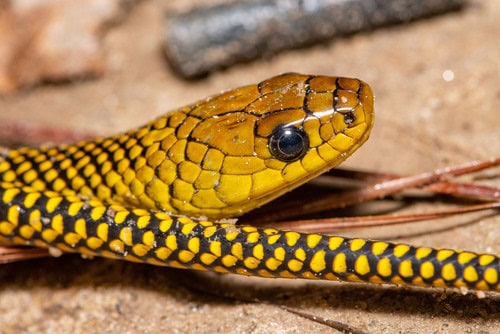
This species is found across much of Brazil, but is especially dense along the southeast coast, including near Sao Paulo, where sightings are legion. The military ground snake (Erythrolamprus miliaris) is typically a black-yellow snake, in rapidly alternating speckles, with virtually no colours between. The proportions of colours vary, with yellow occasionally dominating and black taking over in others.
Military ground snakes occupy altitudes of 100-700 metres, avoiding highlands. They’re found in Atlantic forests and riverside gallery forests, where they’re usually found close to water bodies, whether resting on the grassy shores or swimming along the well vegetated edges. This is a short snake, at an average of 50cm. A 2020 study reviewed their diet, listing 38 prey identified to the species level. Of these, 79% were amphibians. 3 reptiles were recorded, including a snake, a Brazilian keelback (Helicops infrataeniatus). A mammal was recorded too, which is unusual for the Erythrolamprus family.
This snake looks as harmless at its cousins, but tests on mice found its venom to be highly haemorrhagic. Whether this translates to humans is yet to be seen.
| 10 | Savannah racer snake |
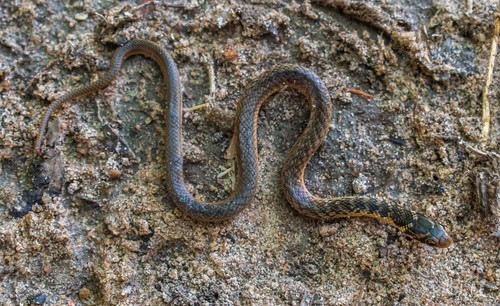
This species inhabits northern Brazil and adjacent nations such as Suriname and eastern Venezuela. As the name suggests, savannah racer snakes (Erythrolamprus aenigma) skip humid rainforests and prefer open savannah areas, at altitudes of 90-900 metres. This species was only identified in 2021, so knowledge is kind of scarce, although local ranch hands probably know more than we do. However, one was spotted eating an annulated cat-eyed snake, and another eating spawn of the whistling grassfrog, which contained both eggs and hatched tadpoles.
Savannah racer snakes have a purple tongue, and look grey from a distance, but actually have rapidly alternating black and cream speckles which blend together from afar. In 2022, scientists found Erythrolamprus aenigma in eastern Colombia, over 1000km west of its previously known western extent. We clearly barely know anything about this snake’s territory. Between the two locations lay enormous swathes of land where it had never been sighted officially.
Savannah racer snakes are relatively dull for the Erythrolamprus family, which might be why they’ve escaped people’s attention. One rare ID feature is a pale neck collar, with a small gap in the centre, resembling the hands of a pinball machine.
